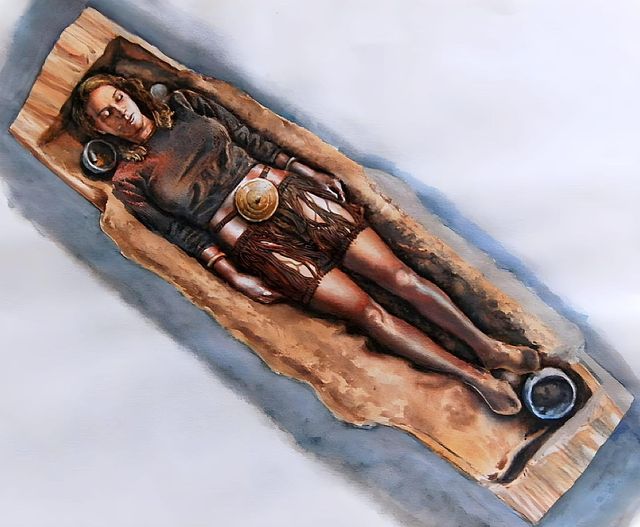Table of Contents
ToggleA Burial in the Bog
The Egtved Girl’s grave was discovered in Egtved, Denmark, encased in a well-preserved oak coffin. While her skeletal remains had decayed over time, the unique conditions of the peat bog—a waterlogged, acidic environment—ensured the preservation of her hair, nails, and clothing. The bog’s microclimate acted as a natural preservative, allowing archaeologists to uncover details that would otherwise have been lost.
What We Know About Her Origins
A groundbreaking 2015 isotopic analysis of her hair and teeth revealed that the Egtved Girl was not native to Denmark. The chemical signatures pointed to her early years being spent in southern Germany, with her diet and water intake aligning with the Black Forest region. This discovery suggests she likely undertook significant journeys during her lifetime, underscoring the mobility of Bronze Age societies.
Her Clothing: A Window into the Past
The Egtved Girl’s attire provides a glimpse into the fashion and symbolism of her time. She wore a wool skirt and a belt adorned with a bronze disk featuring spiral motifs. This design has been associated with Scandinavian sun cults, hinting at her possible religious role. The wool itself was traced back to southern Germany, emphasizing the extensive trade networks of the era.
Her clothing was not merely functional but symbolic, reflecting her identity and societal status. The craftsmanship highlights the advanced textile-making techniques of the Bronze Age, including spinning, weaving, and dyeing.

A Priestess or a Political Figure?
The artifacts in her grave and the symbolism of her attire suggest she may have been a priestess in a sun cult—a religious tradition that revered the sun as a life-giving force. Alternatively, historians propose that she could have been part of a strategic marriage alliance between elite groups in Denmark and southern Germany. This theory posits that such unions were crucial for fostering political ties and maintaining power across regions.
Whether priestess or diplomat, the Egtved Girl’s burial highlights her importance within her society. Her presence in Denmark may reflect the interconnectedness of Bronze Age Europe, where shared beliefs and political alliances crossed geographic boundaries.
Trade, Mobility, and Cultural Exchange in the Bronze Age
The Egtved Girl’s story is emblematic of the broader patterns of trade and mobility during the Bronze Age. Wool from the Black Forest, bronze artifacts, and shared religious motifs suggest that goods, ideas, and people moved freely between regions. This interconnectedness challenges the notion of ancient societies as isolated and reveals a dynamic cultural landscape.
Lessons from the Egtved Girl
The discovery of the Egtved Girl has provided invaluable insights into Bronze Age life. Her well-preserved remains and grave goods illustrate:
- Religious Practices: The emphasis on sun motifs suggests a shared religious tradition across northern Europe.
- Role of Women: As a priestess or diplomatic figure, the Egtved Girl exemplifies the critical roles women played in ancient societies.
- Technological Sophistication: The quality of her clothing and artifacts reflects advanced craftsmanship and resource exchange.
Conclusion: The Legacy of the Egtved Girl
The Egtved Girl’s story is a testament to the complexity of Bronze Age societies. Her burial connects the cultural, political, and religious practices of Denmark and southern Germany, illustrating the deep ties that spanned Europe 3,400 years ago. As new analytical techniques emerge, her remains continue to offer valuable insights, reminding us of the enduring legacy of ancient peoples and their remarkable achievements.
